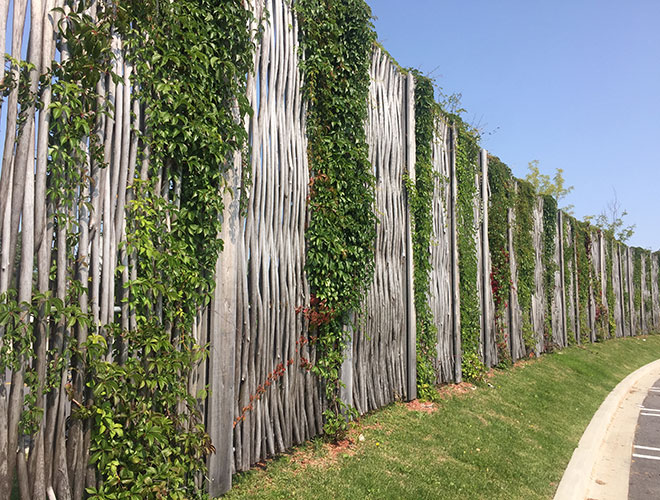
Sound- and Noise barriers
Call or write for advice or an offer. We are ready on phone 98 96 20 71. We deliver CE-certified solutions that ensure optimal attenuation of the noise – and in the most beautiful way. On this page you will find an introduction to noise screen types – and we have a simple overview of prices in our webshop
Sound barriers made from sustainable wood
The first requirement for a noise screen – regardless of whether the builder is a private home owner or the Ministry of Transport – is that it provides effective noise attenuation. It is crucial here that the screen both isolates and absorbs the noise. At the same time, the construction must be thoroughly tested and designed to be a safe design that, after assembly, cannot topple over or pose a risk to the surroundings. This applies regardless of whether you choose a DIY solution or a professional fitter.
A long life spand and minimal maintenance are also good features to be aware of. Here, keep an eye on whether the noise screen is CE certified. It ensures that the stated technical features are reliable, for example whether the noise screen dampens the noise in accordance with what is stated. As a buyer, you are always better off when you have invested in a CE-certified product.
While the technical features are always the first and most important parameters, the noise screen’s design and sustainability are nevertheless equally important for all of PileBygs products. The UN’s 17 Sustainable Development Goals have been made into everyday goals. They are set down in a DOGME we have drawn up as a value basis for our work.
Noise screens for professionals
For more than 30 years, we have worked with the development and processing of products based on fast growing forrests (willows). Today, our noise screens has its own industry name: natur noise screens. We supply noise screens adapted to the needs of both the private home owner and cottage owner, as well as the public builder who needs to shield the noise from large infrastructure facilities.
We have many years of experience in delivering the same design, finish and quality for the private residential road as for the highway, by adapting functionality and technical features to what the two types of facilities each require.
This is also essential to ensure, what we call democratic prices. This means that with a simpler technique for smaller noise screens, private individuals can also afford to ensure peace and quiet in the garden.
Therefore, our clients at home and abroad make up a broad group of very different buyers. As one of our first projects, we have delivered a still very beautiful noise screen to The Housing Association Nyvangen in Ballerup, and as one of the most recent we helped to provide the new approach road at Silkeborg – Nordskovvej – with a beautiful solution for noise reduction.
The democratic prices on our noise screens have been achieved by adapting material consumption and assembly technique to the needs of the individual client. A garden does not need the same foundation and statics as the noise screen that is delivered for a large project along a highway. Our clients at home and abroad include State, Industry, housing associations, institutions and foundations.
Climate noise screen
The climate screen is a noise screen with a built-in LAR function (Local Drainage Of Rainwater). It is designed to deal with cloudburst problems, for example rain from the city’s roofs, which can be directed down into the core of the screen, where the water is stored and evaporates.
The climate screen is built according to PileByg’s CE-certified principle for natural noise screens – and it therefore isolates and absorbs noise like a regular noise screen. LAR solutions are usually space-consuming and/or must be placed underground. The climate screen is therefore an ideal solution in the dense city. The screen can also be thought of as urban renewal – read more about the climate screen here
Graffiti
A nature-like and rough, uneven facade does not encourage graffiti, and experience shows that where graffiti has been attempted on PileByg facades, the vandal has given up. It does not work to paint on the willow braid. The paint disappears into the raw facade. Experience also shows that the natural aging of the facade, which is part of the unique design of PileByg noise screens, ensures that graffiti is eroded away by wind and weather.
The natural screens have a 67% lower climate footprint than conventional noise screens and they require minimal or no maintenance. The screen’s statics are calculated on the basis of steel and acacia in a sandwich construction, where the facades patina with the grace of nature. Whole logs patina differently than cut wood; for example, planks and slats where the wood has been cut (the wood fibers have been cut/opened) will have cracks and fissures that call for wood protection. The willow trunks have an unbroken surface and no truncated wood fibers. Therefore, they patina and age beautifully, without the use of chemicals.
General specifications
01
CE-certified according to EN 14-388 (as required by EC-legislation since 2007).
02
Developed to isolate and absorb the noise – an optimal combination for noise reduction. The noise is not reflected.
03
67% more sustainable than conventional noise fences, calculated by SWECO. Complete circular economy is our ultimate development goal.
04
No costs for cleaning, wood treatment or chemicals for graffiti removal.
05
The green barriers are designed with facades which gracefully go old – like nature itself, they only become more beautiful with age.
06
26 to 36 years of life expectancy on all parts depending on the type of noise screen.
A noise screen should be both economically and environmentally sustainable
The natural screens require minimal or no maintenance. The statics of the noise screen are calculated on the basis of steel and acacia wood in a sandwich-like construction, where the facades ages with the grace of nature. Whole stems age differently than cut wood – for example, planks and slats where the wood has been cut into few cracks and fissures, will call for wood protection.
The willow stems have an unbroken surface and no shortened wood fibers. Therefore, they age beautifully, without any use of chemicals. A wise and extensive maintenance strategy is both financially saving and environmentally sustainable – and a very fine example of how the UN’s 17 Sustainable Development Goals are put into practice.
The most efficient noise abatement of outdoor noise along highways, roads and railways is to install acoustic barriers.
The placement of a noise fence will most often take place in separation from a neighbour/resident, along a road or lane. However, it is important to place the noise fence as close to the noise source, or as close to the house as possible. This achieves the greatest noise attenuation using the noise fence.
Noise is measured in the unit dB(A). The noise level on a main road in the city (50 km/h), with 4,000 cars per day, is approx. 63 dB(A) measured 10 meters from the center of the road. A reduction of 5 dB(A) will be clearly audible, while a reduction of 10 dB(A) will be perceived as half as loud as the original noise level.
Attenuation of 5-10 dB(A) is relatively easy to achieve with a ROCKWOOL® stone wool core. Noise attenuation or sound attenuation is expressed in noise isolation value and shielding effect. A noise fence must not allow sound to pass through the noise fence. However, it is next to impossible to achieve a 100% soundproof noise fence. Therefore, it is sufficient that the noise that passes through the noise fence is negligible compared to the noise that passes over the noise fence.
The noise that passes through the noise screen must per definition have no effect on the total attenuation. The noise insulation (reduction of noise through the noise screen) must be approx. 10 dB(A) louder than the noise barrier effect (the total attenuation). In other words, if you want to reduce the total noise by 10 dB(A), the noise that passes through the noise fence must be reduced by a minimum of 20 dB(A).
In addition to dampening the noise on your own property, it is important not to add additional noise annoyances to neighbours/residents as a result of sound reflections. If the sound is thrown back from the noise screen, it must be added to the noise level that already exists at the neighbour/resident. This often means an increase of approx. 3 dB(A), which does not initially sound like much, but in reality it is perceived as doubling the traffic.
Documented measurements show a noise absorption of 95%. Meaning; the noise is not thrown back, but is dampened in the noise fence.
Delivery and installation of noise screens from PileByg
Our help is available throughout the entire process, from choosing the correct solution to delivery and installation. Depending on the requirements of the location and lifespan of the noise screen, the noise screen is delivered with statics and dimensions adapted to the given location.
The facades can be combined, and we provide free advice on the choice and design of the noise screen. All screens are CE-certified in accordance with EN 14388 and are delivered either as prefab elements ready for installation or for flexible assembly DIY.

PREFAB sound barrier CLASSIC
Client: Grundejerforeningen Skejbygaard
Sound barrier CLASSIC facade in debarked willow and larch lamella // 420 m2 // Built in 2021

PileByg CLASSIC sound barrier
Client: Statens Vegvesen, Sandnes, Norge.
Nutural Barrier in willow // 735m2 // Built in 2011

PileByg CLASSIC sound barrier
Client: Vestfold Krematorium
Natural Barrier in willow // 625m2 // Built in 2010

PileByg CLASSIC sound barrier
Client: Privat Boligforening, Nyvangen Ballerup
Natural barrier // 280 m2 // Built in 2000

PileByg CLASSIC sound barrier
Client: Kyrkbyskolan, Göteborg Kommune
Natural barrier with face of wilow // 321 m2 // Built in 2012

SELECTION OF WILLOW
Dansk træ fra klimaskove











